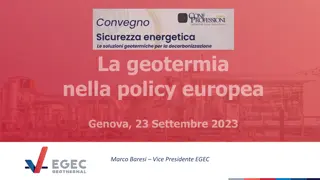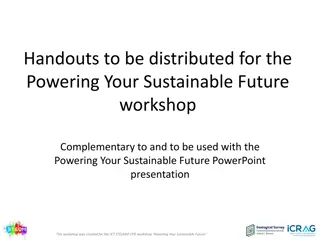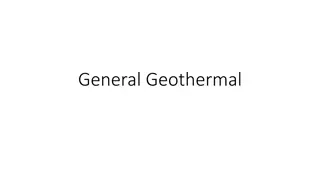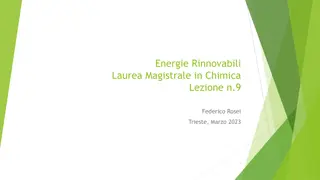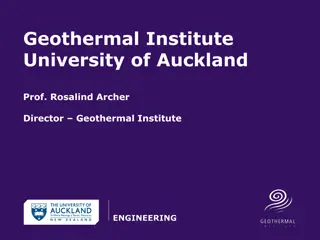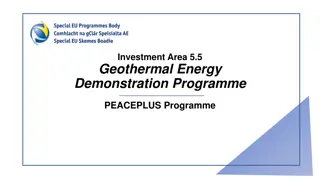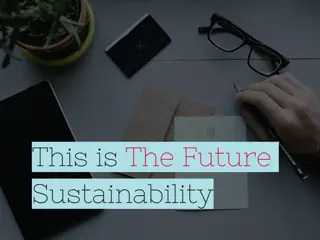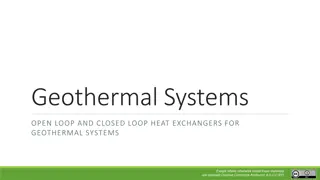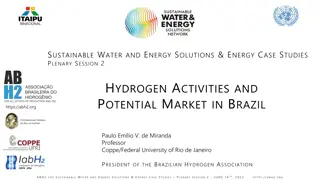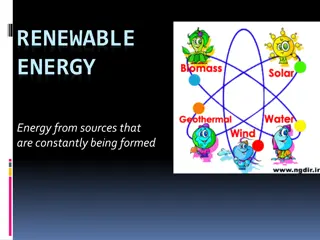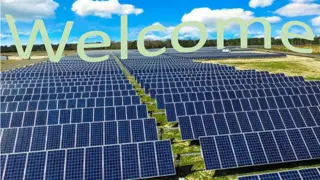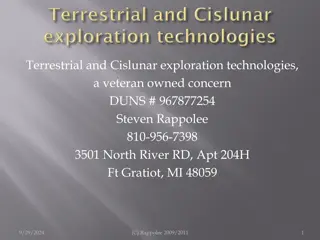Exploring Geothermal Energy: A Sustainable Energy Source
Geothermal energy, a natural heat source within the Earth, offers a clean, renewable, and underutilized energy option. This seminar covers the history, applications, advantages, disadvantages, and future prospects of geothermal energy, emphasizing its potential as a reliable and homegrown energy source. From space heating to power generation, geothermal energy's diverse applications demonstrate its environmental and economic benefits.
Download Presentation

Please find below an Image/Link to download the presentation.
The content on the website is provided AS IS for your information and personal use only. It may not be sold, licensed, or shared on other websites without obtaining consent from the author. Download presentation by click this link. If you encounter any issues during the download, it is possible that the publisher has removed the file from their server.
E N D
Presentation Transcript
www.studymafia.net Seminar On Geothermal Energy Submitted To: www.studymafia.net www.studymafia.net Submitted By:
Index Introduction What is Geothermal Energy History Applications Types Uses of Geothermal Energy Advantages Disadvantages Future of Geothermal Energy Conclusion References
INTRODUCTION Geothermal energy is the earth s natural heat available inside the earth. This thermal energy contained in the rock and fluid that filled up fractures and pores in the earth s crust can profitably be used for various purposes. Geothermal energy is an enormous, underused heat and power resource that is clean (emits little or no greenhouse gases), reliable (average system availability of 95%), and homegrown (making us less dependent on foreign oil).
WHAT IS GEOTHERMAL ENERGY? Geothermal energy is defined as heat from the Earth. It is a clean, renewable resource that provides energy in the U.S. and around the world in a variety of applications and resources.
HISTORY Paleo-American Indians used hot springs in this area Hot Springs, Arkansas had $1 hot baths in 1830 First electricity (20kW) from geothermal produced from natural steam in Larderello, Italy in 1904 [Kruger, 1973] New Zealand s north island gets 6% of its electricity from geothermal energy 1920: test boring in Niland CA 1922: electricity generation in The Geysers 1950: 95 F, 220kW generating plant in Katanga The Geysers CA expanded to 600MW in 1975
APPLICATIONS 1. Space/District Heating: Schemes utilizing geothermal heat provide over 80% of the central heating needs of Reykjavik city in Iceland and are employed in many towns in USA, Poland and Hungary. 2. Agriculture and Aquaculture: In temperate and colder climates, greatly improved plant and fish growth can be achieved by heating soils, greenhouses and fish ponds using geothermal heat. 3. Power Generation: With over 8000 MW of installed capacity, geothermal electric power generation is a well-proven technology that has been especially successful in countries and islands that have a high reliance on imported fossil fuels (World Bank Group, 2004).
THE STRUCTURE OF THE EARTH The heat contained within the earth would cover our present world energy need for 30 million years. When you look at the temperature in and on Earth you can see that 99% of the planet has a temperature over 1000 C, while only 0.1% of the earth is cooler than 100 C.
COSTS OF GEOTHERMAL ENERGY Costs for geothermal electricity generation are 4.5-7 cents per kilowatt-hour. This is competitive with some fossil fuel facilities, but one must keep in mind the drastic reduction of pollution. Delivered costs depend on ownership arrangements, financing, transmission, the quality of the resource, and the size of the project. Geothermal plants are relatively capital-intensive, with low variable costs and no fuel costs.
WHERE IS GEOTHERMAL ENERGY FOUND? What does geothermal energy look like? Some visible features of geothermal energy are volcanoes, hot springs, geysers, and fumaroles. But you cannot see most geothermal energy. Usually geothermal energy is deep underground. There may be no clues above ground to what exists below ground.
ENVIRONMENT Geothermal energy is a renewable energy source that does little damage to the environment. Geothermal steam and hot water do contain naturally occurring traces of hydrogen sulfide (a gas that smells like rotten eggs) and other gases and chemicals that can be harmful in high concentrations.
USES OF GEOTHERMAL ENERGY Industrial processes Geothermal prawn farming Horticulture Crop and timber drying
TYPES Liquid-dominated plants Liquid-dominated reservoirs (LDRs) are more common with temperatures greater than 200 C (392 F) and are found near young volcanoes surrounding the Pacific Ocean and in rift zones and hot spots. Thermal energy Lower temperature sources produce the energy equivalent of 100M BBL per year. Sources with temperatures from 30-150 C are used without conversion to electricity for as district heating, greenhouses, fisheries, mineral recovery, industrial process heating and bathing in 75 countries.
TYPES . Enhanced geothermal Enhanced geothermal systems (EGS) actively inject water into wells to be heated and pumped back out. The water is injected under high pressure to expand existing rock fissures to enable the water to freely flow in and out.
ADVANTAGES It is a renewable source of energy. By far, it is non-polluting and environment friendly. There is no wastage or generation of by-products. Geothermal energy can be used directly. In ancient times, people used this source of energy for heating homes, cooking, etc.
DISADVANTAGES Only few sites have the potential of Geothermal Energy. Most of the sites, where geothermal energy is produced, are far from markets or cities, where it needs to be consumed. Total generation potential of this source is too small. There is always a danger of eruption of volcano.
ENERGY SOURCE: GEOTHERMAL Capturing and Using Geothermal The most common current way of capturing the geothermal energy is to tap into naturally occurring hydrothermal convection systems containing pressurized hot water or steam. Benefits Geothermal power plants do not have to use an intermediate technology to produce steam to power the turbine generators. The landneeded for geothermal power plants is smaller per megawatt than for almost any other type of power plant.
CHALLENGES Geothermal energy can only be used in areas where the earth's crust is thin and the steam or hot water sources are close to the surface. Sometimes the hot water that is pumped to the surface contains pollutants such as sulphur, which must be removed before using in a power plant.
GLOBAL STATUS AND POTENTIAL Geothermal energy is used widely in Iceland, the Philippines, Italy, Indonesia, Mexico, New Zealand, Japan and China. Iceland relies on geysers as its primary source of heat. The United States is the world's largest producer of geothermal electricity with 2,800 MW in service.
FUTURE OF GEOTHERMAL ENERGY The future of geothermal energy depends on three factors: it s demand, supply and it s competitiveness among other renewable resources in terms of cost, availability, reliability etc.
CONCLUSION Geothermal energy is limited in extent as extracting the heat usually exceeds the replenishment rate Hot, dry rock (HDR) is widespread and offers new resources in areas where geyser activity is unknown Direct low-temperature heat transfer for home systems is practical as long as low maintenance is designed into the system Sources of high temperature water or steam are limited and the cost of extraction, maintenance, and operation will remain high in comparison with other sources of energy
REFERENCE www.studymafia.net www.google.com www.wikipedia.com
THANKS TO STUDYMAFIA.ORG




